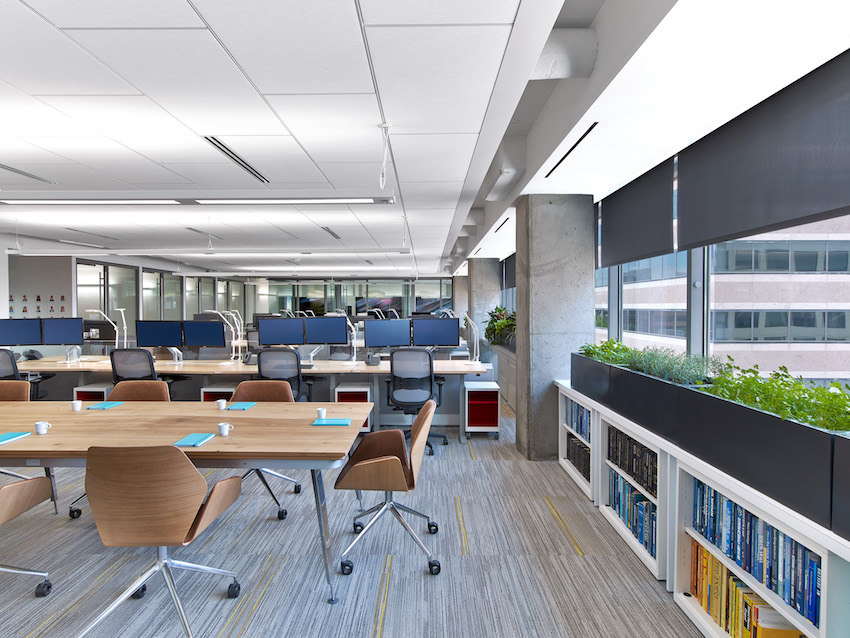Daylight Autonomy 101
Introducing Daylight Autonomy
Today, designing a space to meet specific daylight-related objectives is a common practice. The usual daylighting goals include achieving some predefined daylight illuminance level on the workplane or at the floor, incorporating some measure of glare control, or delivering a daylight zone of a certain size. Achieving daylight autonomy essentially requires a project to achieve all of the above and more.
The 10th edition of The Lighting Handbook, published by the IES (Illuminating Engineering Society of North America, formerly IESNA), defines daylight autonomy as “the percentage of the operating period (or number of hours) that a particular daylight level is exceeded throughout the year.” It is a dramatically different way to think about and measure the presence of daylight in a building. “One advantage of using daylight autonomy to quantify daylight availability in a building, is that the daylight autonomy calculations take climate into account, an aspect that previous metrics for quantifying daylight had not included,” explained Jack Bailey, Partner at One Lux Studio in New York City. “This metric could benefit architects and owners significantly. Architects can use daylight autonomy analysis to evaluate different design alternatives to determine which concept provides more usable daylight in the interior, and owners will know, definitively, that their building is making good use of daylight. It also provides a consistent metric for comparing the performance of different buildings for building codes and green building initiatives.”
It should be noted that at this moment achieving daylight autonomy in a building is not required by any international, federal, state or local building code. “It was included in the first public draft of the International Green Construction Code (IgCC), but was removed in favor of a simpler metric,” explains Bailey, who served on the committee that wrote the IgCC. “Nor is daylight autonomy analysis required for a project wishing to achieve LEED or any other type of green building certification,” he continues, “however, daylight autonomy is recognized as an option for achieving the daylighting credit in LEED v4.”
Metrics for Measuring Daylight Autonomy
Where daylight autonomy is the goal, it is critical to understand that a high daylight autonomy value does not necessarily create a productive, comfortable, energy-efficient daylit space. The DA value of a given point in a space represents the percentage of annual daytime hours that daylight levels exceed a predefined illumination level. When the defined threshold is the recommended illumination level for the space, the DA value indicates the amount of time that the interior space could be exclusively illuminated with daylight. For example, consider a location in an office space where the target daylight level is 30 footcandles (DA30) and the DA value is 87 percent. This means that area of the office receives at least 30 fc of daylight for 87 percent of the workday, enabling the overhead electric lights to be turned off a substantial amount of time every day.
While the DA metric indicates the amount of time every day that predefined minimum daylight levels have been achieved, it does not consider whether the available daylight is, in fact, too bright to use in the space, without a daylight management mechanism. In order to achieve a more complete picture of the presence of daylight in a space and ensure that the design adequately protects the interior from glare, there are a few additional metrics that should be considered.
Spatial daylight autonomy (sDA) refers to the percentage of floor area where 30 fc is achieved for at least 50 percent of the workday. Higher sDA values indicates that a larger interior space receives at least 30 fc of daylight for at least 50 percent of the workday. Generally, sDA is calculated using a daylight simulation tool that computes the daylight levels in the space for every hour of the year. Although there are many DA metrics, sDA has become the most common due to its inclusion in LEED v4 and the WELL Building Standard.
There is a metric that identifies the presence of extremely bright or direct daylight in the interior space. The annual sunlight exposure (aSE) metric identifies the percentage of the floor area that receives intense daylight, exceeding 100 fc, for more than 250 work hours every year. This metric is included as a design consideration in both the LEED v4 rating system and the WELL Building Standard. For example, to achieve the LEED v4 Daylight credit, a project must have a maximum aSE value of 10 percent.
Beyond identifying the exposure to intense daylight that a space receives, there is also a metric that measures the amount of useful daylight that a space receives. The idea of useful daylight revolves around the level of daylight that can be introduced into a space without causing glare or disrupting the visual environment. That range of useful, glare-free daylight is generally considered to be between 10 and 200 fc at the workplane. Useful daylight illuminance (UDI) refers to the percentage of work hours where the illuminance from daylight in a space is between 10 and 200 fc.
There is also a metric that measures the perception of glare. Daylight glare probability (DGP) quantifies occupants’ perceived glare from daylight. It is calculated by evaluating the entire visual field of a potential occupant, taking into account the light intensity, size of the glare source, contrast, and its position in the field of view. DGP is generally considered the best metric to evaluate glare potential today.

Photo: © Eric Laignel
The ASID Headquarters in Washington, D.C., used an automated shading system to satisfy criteria in both the LEED v4 green rating system and the WELL Building Standard.









